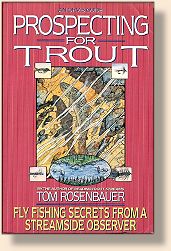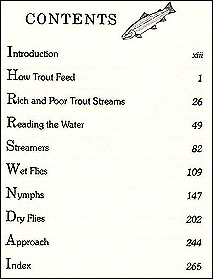|
The Internet is a powerful resource. It provides us instant
access to information, and brings us together via email,
bulletin boards, chat rooms, and instant messaging. FAOL
is a wonderful example of the Internet at its best. The Internet,
however, will never replace the printed page.
I've loved books and fishing since my youngest years, although
I did not start fly fishing until 1993. This column will give
me an opportunity to share reviews of some of my favorite fly
fishing and tying books (and some that are not such favorites)
with my friends here at FAOL. My library reflects my tastes
and interests, and so will this column. It will be heavily
slanted towards cold water fishing and tying for trout and
steelhead, and won't touch much on areas of which I know little,
such as warm or salt water fishing.
I hope that these reviews will motivate some of you to pick up
a good book, on this or any subject, and read.
~ Stu Farnham
Prospecting for Trout
 Prospecting for Trout: Fly Fishing Secrets from a Streamside Observer (An Orvis Guide)
Prospecting for Trout: Fly Fishing Secrets from a Streamside Observer (An Orvis Guide)
By Tom Rosenbauer
Paperback (271 pages)
Publisher: Delta; (April 1993)
ISBN: ISBN: 0385308167
Last week, in a review of Tom Rosenbauer's Reading Trout
Streams, I mentioned that Tom is among my favorite fly
fishing writers. This week's review is of another of Tom's
books. Like Reading Trout Streams, this book
was re-released in a new edition as part of The Orvis Guide,
- flyfishing series. The copy in my library is the original
1993 edition, which is reviewed here.
The topic of the book is simply stated: how to fish in the
absence of obvious fish activity. Followers of Halford have
lost interest at this point, but for most of us this describes
the majority of the trout fishing we do.
Rosenbauer starts the book by reviewing the basics of trout
feeding behavior, selectivity, trout senses (mostly vision),
territoriality, and rising behavior. He also reviews the
effects of sunlight and temperature.
Next comes some stream ecology contrasting rich spring creeks
with the relatively poor watersheds that drain the seaward
slopes of our coastal mountain ranges in the US. Rich streams,
with their abundant, steady food supplies, tend to produce
larger trout. The abundance of food (combined with increases
in fishing pressure as the trout fishing population increases
and become more mobile), however, often makes those large fish
highly selective. Fish in poor streams do not grow as large,
but the relative scarcity of food makes them feed more
opportunistically.
There's a chapter on reading the water, sort of the Reader's
Digest condensed version of the book reviewed here last week.

The bulk of the remainder of the book describe searching strategies
based on the type of fly being fished: streamers, traditional
wet flies, nymphs, and dries. The chapter on streamers discusses
various hypotheses about why trout take streamers; these
motivations will inform your fishing tactics. Tom then
takes you through streamer strategies based on time of
ay and year, and presents the basic techniques for
streamer fishing. Being mostly a nymph and dry fly
fisher, I found Rosenbauer's short course in Streamers
101 highly instructive.
What's the difference between a streamer and a wet fly? For
one thing, streamers generally imitate non-insect food forms
(bait fish, fry, crustaceans), while wet flies for the most
part represent the immature forms of aquatic insects. For
another, streamers are most often fished with an active
presentation, while wet files are usually fished on the
swing (or, occasionally, dead drift). Action is sometimes
applied at the end of the swing to provoke a take (as is
the case with the famous Leisenring lift technique).
Rosenbauer spends most of this chapter on presentation
techniques for the wet fly.
Many fly fishers express a decided preference for fishing
the dry fly. More than a few of us switch to nymphs only
reluctantly, and our technique reflects it. Others speak
of strike indicators as bobbers, suggesting that nymph
fishing does not require much skill. In my opinion, nymph
fishing is a harder skill to master than the dry fly: you
need to control your presentation in three dimensions, not
two, and do so without being able to see your fly. A
skilled nymph fishers is constantly adjusting their
terminal tackle to match conditions, and skillfully
mending their line to control presentation. Tom talks
about the importance of nymphs in the trout's diet,
explains behavioral drift, presents some rules-of-thumb
for fly selection, reviews the use of strike indicatiors,
and goes over presentation techniques. Although this is
a book on searching techniques, there is also good
information on nymphing to visible fish.
When is a dry fly a good choice for fishing the water?
Rising to take a floating insect involves a greater
expenditure of energy than taking a nymph. The greater
the distance a trout needs to rise, and the harder the
current the trout needs to fight, the less net energy
is gotten from the food. So, Rosenbauer asserts, depth
and speed of water are keys to choosing a searching dry.
He reviews pattern selection, terrestrial fishing, and
presentation, both drag free and active. The book ends
with a chapter on approach. ~ Stu Farnham
About Stu
 Stu Farnham is a New Englander by birth, who was transplanted to
and put down roots in Oregon in the early 1990s, now residing in
the Seattle area. A software engineering manager by vocation,
he can be found in his spare time chasing trout and steelhead
in the rivers of the Pacific Northwest, chasing his four Gordon
Setters (who in turn are chasing chukar), tying flies, reading,
or working on his website. Colleen, his long suffering wife of
28 years, is a professionally trained personal chef.
Stu Farnham is a New Englander by birth, who was transplanted to
and put down roots in Oregon in the early 1990s, now residing in
the Seattle area. A software engineering manager by vocation,
he can be found in his spare time chasing trout and steelhead
in the rivers of the Pacific Northwest, chasing his four Gordon
Setters (who in turn are chasing chukar), tying flies, reading,
or working on his website. Colleen, his long suffering wife of
28 years, is a professionally trained personal chef.
|

 Prospecting for Trout: Fly Fishing Secrets from a Streamside Observer (An Orvis Guide)
Prospecting for Trout: Fly Fishing Secrets from a Streamside Observer (An Orvis Guide) Stu Farnham is a New Englander by birth, who was transplanted to
and put down roots in Oregon in the early 1990s, now residing in
the Seattle area. A software engineering manager by vocation,
he can be found in his spare time chasing trout and steelhead
in the rivers of the Pacific Northwest, chasing his four Gordon
Setters (who in turn are chasing chukar), tying flies, reading,
or working on his website. Colleen, his long suffering wife of
28 years, is a professionally trained personal chef.
Stu Farnham is a New Englander by birth, who was transplanted to
and put down roots in Oregon in the early 1990s, now residing in
the Seattle area. A software engineering manager by vocation,
he can be found in his spare time chasing trout and steelhead
in the rivers of the Pacific Northwest, chasing his four Gordon
Setters (who in turn are chasing chukar), tying flies, reading,
or working on his website. Colleen, his long suffering wife of
28 years, is a professionally trained personal chef.
